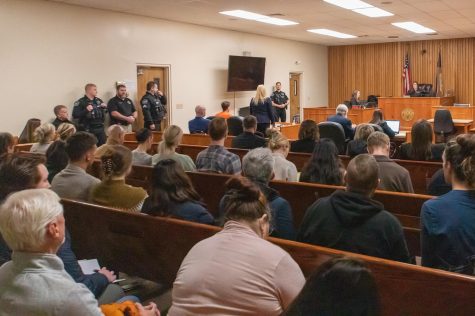Breaking the silence, stigma surrounding domestic violence
Alternatives to Violence of the Palouse’s 24-hour hotline received 3,635 calls in one year; Pullman PD responded to around 100 criminal domestic violence incidents
If you need help, please contact the Alternatives to Violence of the Palouse 24-hour hotline.
March 18, 2021
Editor’s Note: This story contains themes of domestic violence, which may be triggering to some people.
Domestic violence takes power away from victims and makes them feel helpless. One domestic violence advocate said discussing abuse can help reduce the stigma around a common but often unreported issue.
“We have to break some of the silence that surrounds domestic violence,” said Andrea Piper-Wentland, associate director for Alternatives to Violence of the Palouse.
The nonprofit organization ATVP defines domestic violence as a series of behaviors that takes power away from survivors and makes them feel helpless, said Maria Ramos, ATVP coordinator of domestic violence services.
The spectrum of domestic violence is much larger than just physical abuse, Piper-Wentland said. Emotional, psychological, verbal and financial abuse are all examples of domestic violence and do not encompass the broad extent of domestic abuse.
Opening the conversation, limiting stigma
ATVP worked with 828 individuals in both Washington and Idaho from July 1, 2019, to June 30, 2020, according to ATVP’s annual program statistics report.
Out of the 828 individuals, 257 were a part of the Washington domestic violence program and 117 were involved in the Washington sexual assault program. The Idaho program had 311 individuals and the Crime Victim Service Center had 143 individuals, according to the report.
ATVP’s 24-hour hotline received 3,635 calls during that period, according to the report.
Society sees survivors of domestic violence as helpless, but this is not the case at all, Piper-Wentland said. Survivors should not be deemed broken and unable to move forward with their lives. Though there is long-term trauma, victims can still thrive.
Victims should feel no judgment, said Chris Engle, Pullman Police Department sergeant. However, the sad reality is people judge victims of domestic violence harshly.
“One of the biggest things that society can do is to drop that judgment,” he said.
Victims are never to blame for the abuse they have endured. Engle said the aggressor is ultimately in control of their behavior; the blame is on them.
The Me Too movement helped open society’s eyes to the reality of an abuser being the cause and responsible party for domestic violence. The public typically puts a lot of judgment and blame on victims with the questions they ask survivors, he said.
“[Judgment’s] not beneficial,” Engle said. “It’s only continuing the harm.”
Eliminating this judgment as a society removes one more obstacle victims face in reaching out for help. Victims want to feel believed, Engle said.
“That doesn’t require political action,” he said. “That’s just about treating each other decently.”
If victims share their experiences, it is important to listen and not offer suggestions. Ramos said to remind them of their courage and connect them to the appropriate resources. People cannot assume they would know how to respond in an abusive situation.
“[Survivors] are not helpless,” Ramos said. “They are powerful.”
Legal aspects, response to domestic violence
The legal definition for domestic violence in Washington is a crime where the offender has an intimate relationship with the victim. Engle said it is extensive and could include various low-level crimes that do not pertain to the stereotypical domestic violence incident.
Illegal activity does not always occur. Although officers cannot do much in the legal domain for these instances, they will advise victims to seek help. Gaslighting is an example of a behavior that does not always result in a criminal offense, Engle said.
Gaslighting occurs when one party is pretending the objective reality does not exist. It is a deceitful action taken by an aggressor to manipulate a victim into thinking reality is different than it is, Engle said. It makes the victim feel crazy.
An example of gaslighting could be an aggressor turning the lights on right after the victim turns them off when leaving a room. The aggressor then questions why the victim had never turned off the lights in the first place, Ramos said.
If gaslighting or any abusive power-in-control dynamic is apparent, officers attempt to separate the two parties. Officers will speak with the victim regarding domestic violence resources like ATVP. Engle said police try to help the victim recognize the abuse and get help if they want it.
“[Domestic violence] isn’t just a personal problem,” Piper-Wetland said. “This is a societal problem.”
Domestic violence does not always have to be a heat-of-the-moment action. Like sexual offense cases, the abuse is not about sex or the love an abuser might have for the victim; the violence is about the abuser’s need or desire to feel in control, Engle said.
If a person wants to report a crime, even if it happened in the past, that person should call and make a report, he said.
Calls reporting domestic violence do not always entail that an abusive incident has occurred, Engle said.
Sometimes neighbors hear yelling and upon responding, officers find a group of friends just playing video games; other times, a domestic dispute could be taking place. All of these instances could be tagged as a domestic violence-related response, he said.
Pullman PD tagged 298 domestic violence-related incidents in the past year, whether it be a criminal or non-criminal. Engle said Pullman PD receives about one report a day.
In the last year, around 100 cases have been tagged as a criminal domestic violence incident, he said.
Reports often come from neighbors who hear a potential altercation or argument. Reports could also come directly from the victim or their family and friends. Upon arriving at the scene, officers take in their surroundings and make many observations, Engle said.
Officers take into account the initial report, their observations and the interviews conducted with both parties to determine what may have happened, he said.
If there is strong evidence a felony crime of violence occurred or assault with an injury involving pain, officers will arrest the aggressor before further investigation is completed, Engle said.
“We need to see individuals held meaningfully accountable,” Piper-Wentland said. “Survivors need to see that.”
Receiving help, preventing retaliation
During a response, officers go through a series of questions with the victim. Research has shown the answers to these questions help predict the potential future danger to the victim. An example of a question would be whether or not the abuser has threatened to kill the victim or cause other harm, Engle said.
If officers determine the victim is in danger of future abuse, officers encourage victims to get out of the situation and speak with domestic violence advocates, he said.
Detectives will also reach out to victims in the future to ensure their abusers have not contacted them again. If victims do not respond to officers’ attempted contact, Engle said police would try to find the victim and ensure their safety.
Engle strongly encourages individuals who feel they are in an abusive relationship to file for a protection order or anti-harassment order. The orders provide an additional layer of consequence for the abuser if they attempt to infiltrate the victims’ space, whether physically, verbally or psychologically, he said.
Engle said the system is designed to protect victims and provide an avenue of escape from the abuse. Even if officers cannot pursue any legal action to protect the victim, they will help point victims in the direction of resources that can further help them.
Resources for survivors, victims of domestic violence
ATVP provides a variety of confidential resources and services to victims for free, Ramos said.
Resources and services include a temporary shelter, financial and legal assistance, advocacy and support groups, education and outreach programs, one-on-one support and a 24-hour hotline, Ramos said.
Whatever the survivor’s needs are, ATVP attempts to meet them all, she said.
Isolation and economic dominance are often factors in a survivor’s difficulty to leave their situation, Ramos said. ATVP will provide resources to help survivors find jobs and other means of living.
ATVP provides avenues for counseling services, even if a victim may not have health insurance or means to pay for their therapy, Ramos said.
The organization also provides extensive safety planning to help keep survivors safe and out of a perpetual abusive cycle. The plan is suited for each survivor’s particular needs. Only that person knows how their partner may react, she said
“Each survivor’s story is different,” Ramos said. “Their needs are gonna be different, so we do our best to meet them.”















